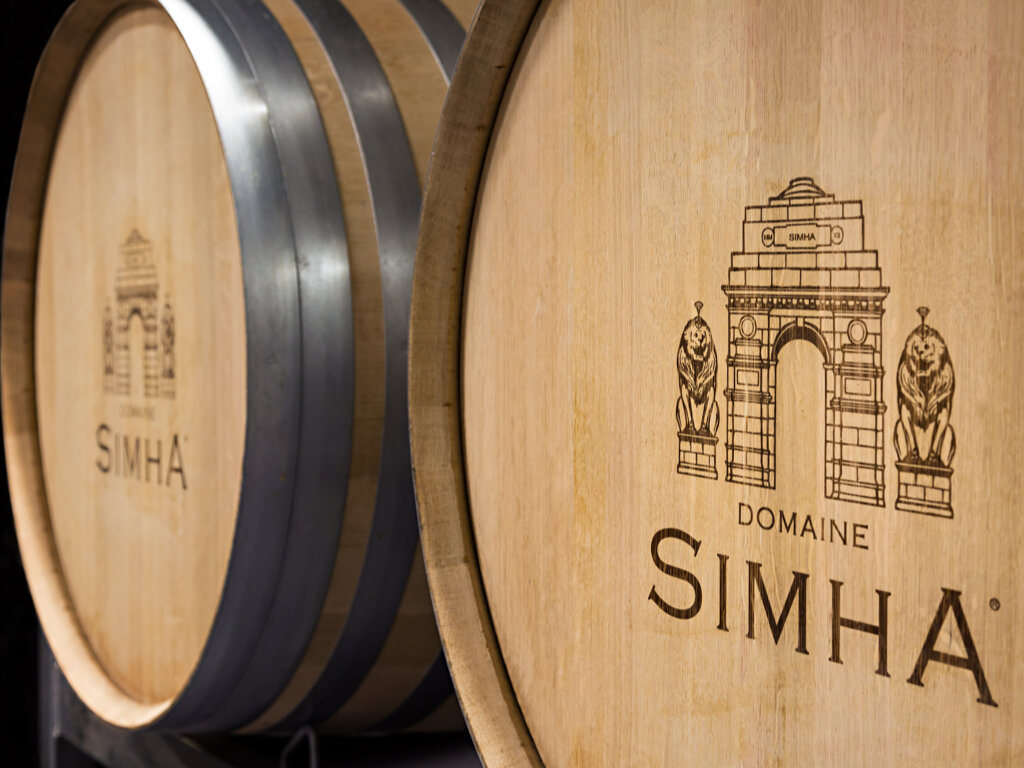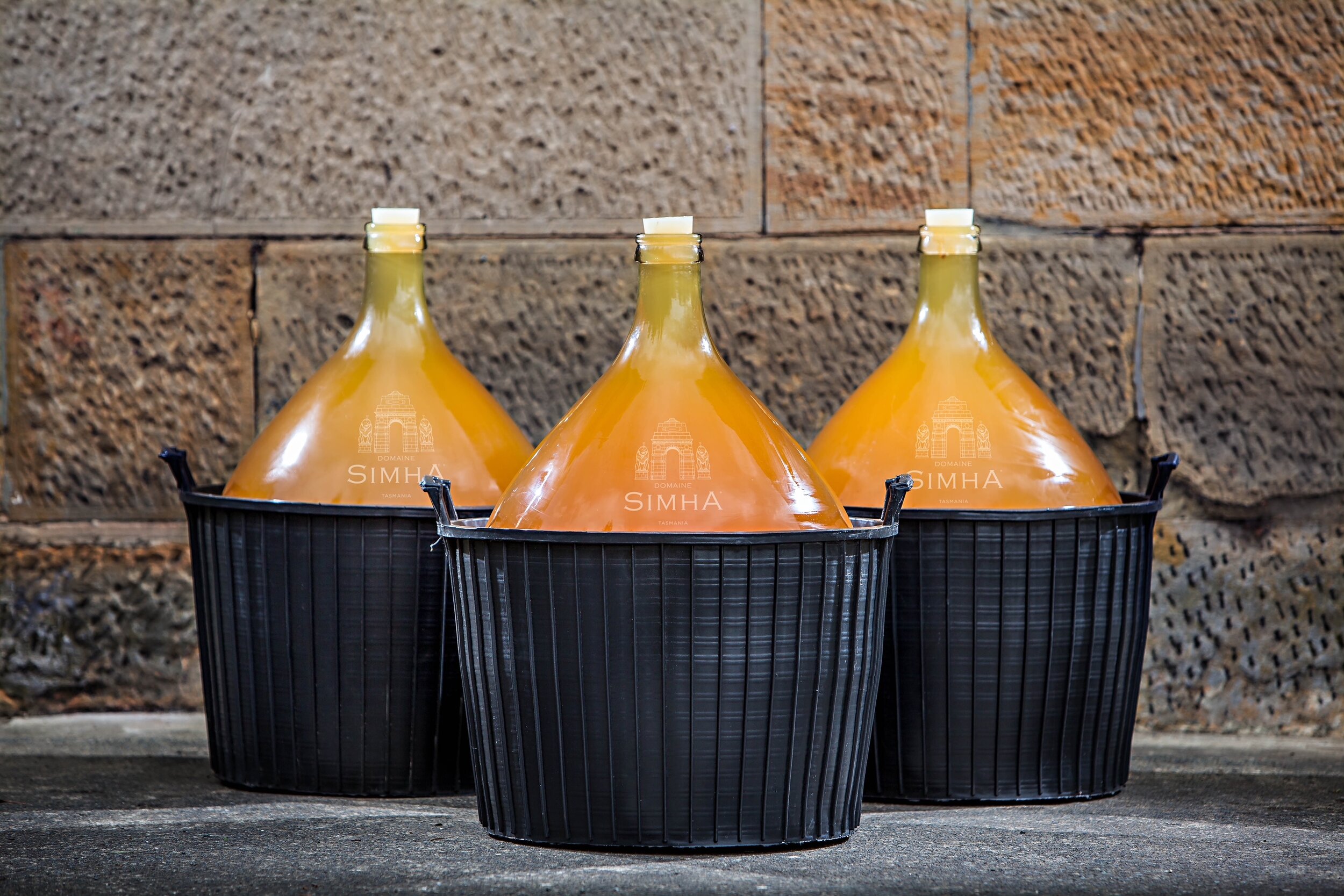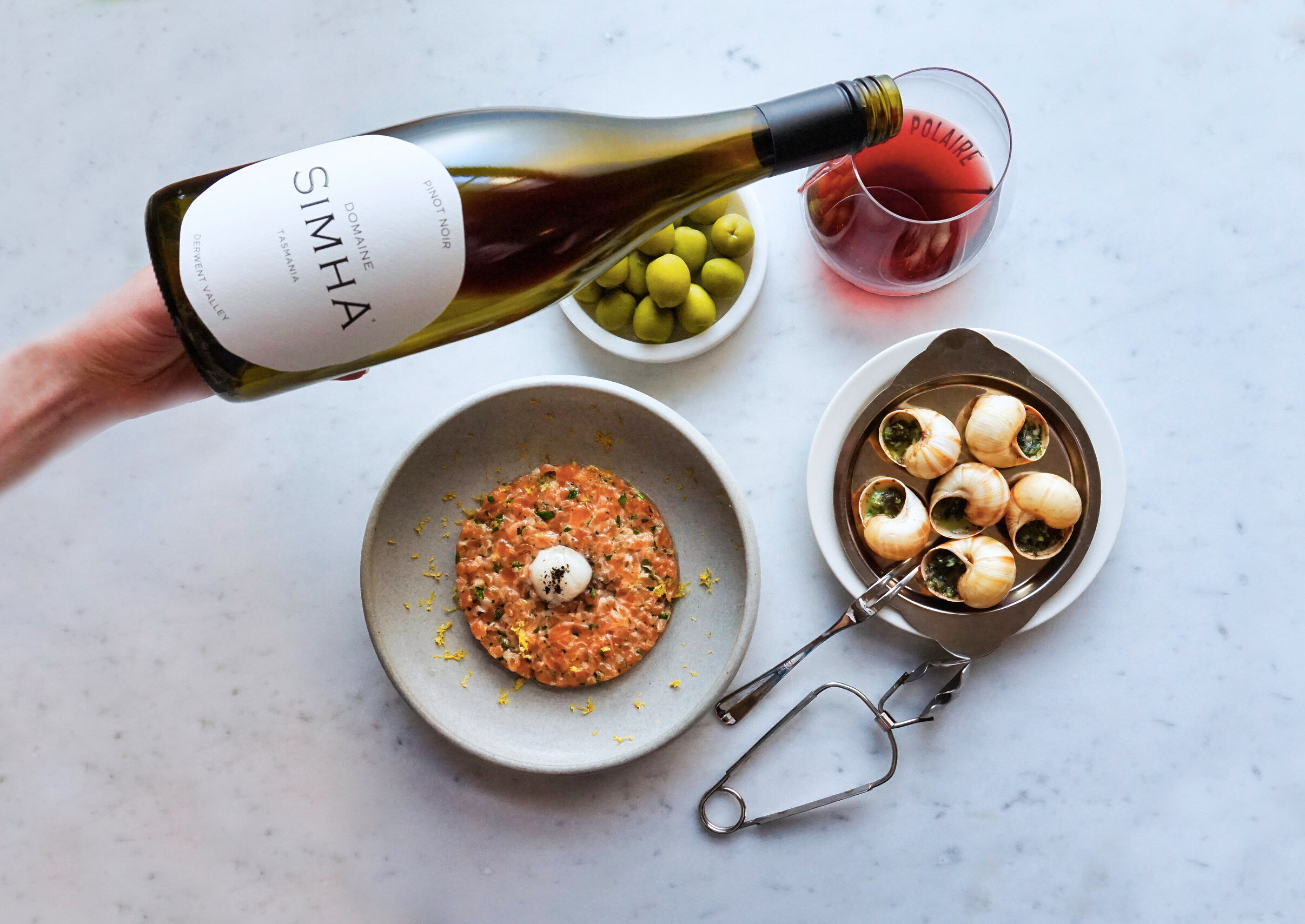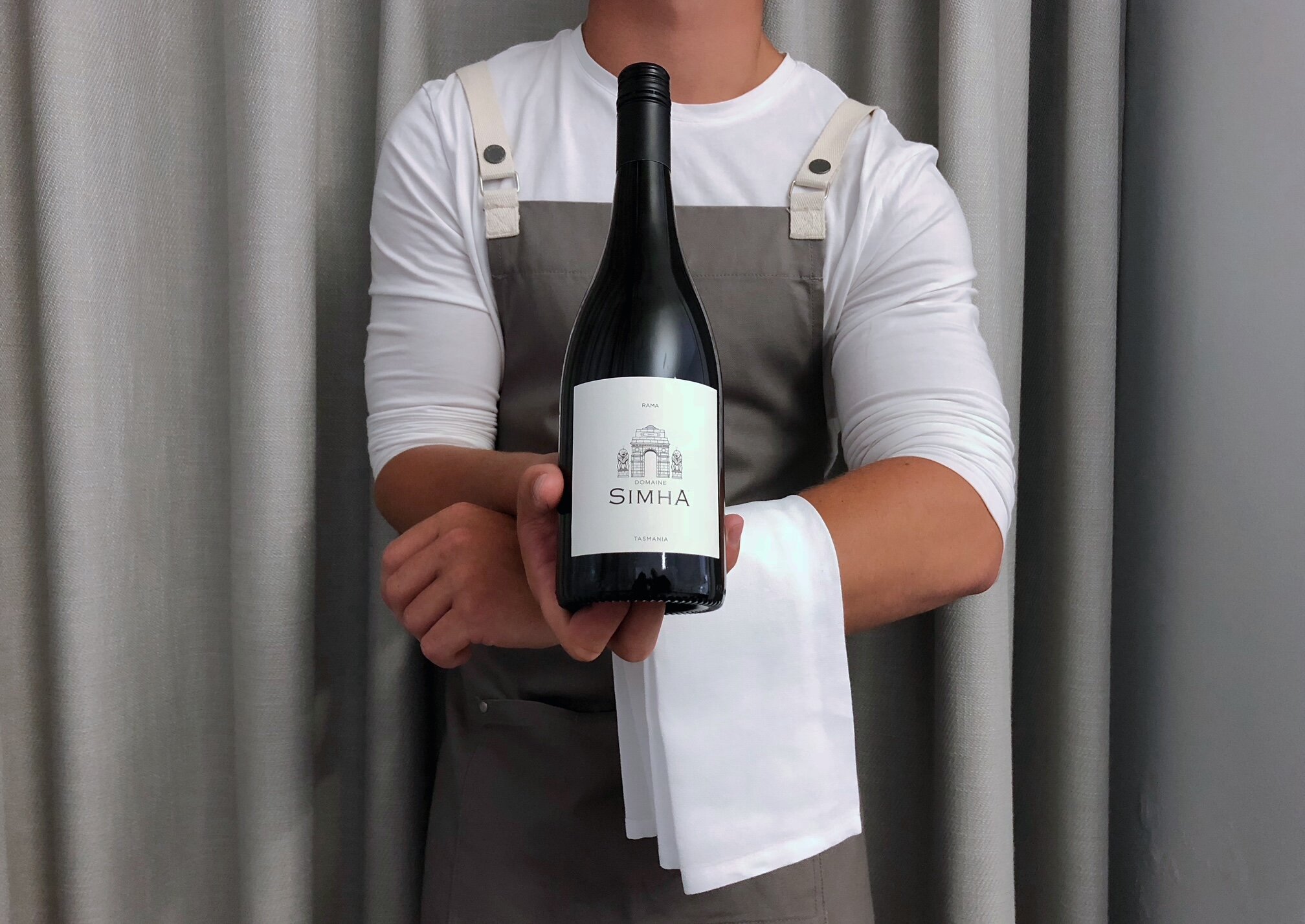Nav Singh on a Sense of Place
Conversation
Nav Singh on a Sense of Place
In a remote corner of the world, Domaine Simha makes some of the most elegant natural wines out there. We’ve spoken to winemaker Nav Singh on what makes Tasmanian terroir so special.
Ambi: Hey Nav! Thanks for taking the time to speak to me. I remember coming across your wines, and meeting you briefly, when I visited Hobart back in 2015. I was really blown away by the quality of your wines, and there was especially this one red blend I've often thought about since. I was quite surprised by it, as I don't usually tend to blend, but it was a wonderful encounter.
Nav: Hi Lene, first of all, thank you for taking the time to expand on our conversation. I remember your visit well and now we have the opportunity to grow those ideas.
We haven’t changed our approach much since the you first tasted our Simla Rouge. Our intention is to remain small and work on the detail of our wine revealing the truest form of terroir. It’s about our drive to make wine, which is always about a sense of place for us.
On that note, can you tell us a bit about your specific location in Tasmania? And what's special about the terroir down there?
Since we began in 2012, most of our grapes come from a single site grower on the upper Derwent Valley close to the lake area.We work with a small parcel of three hectares of land at Meadowbank that is some of Tasmania’s finest and oldest vines. We also keep our eye out for rare and interesting parcels from other sites in order to really tell that story of the place.
It’s always been our focus to capture that unique character and drive of what Tasmania is. The reason Tasmania is exciting is because it’s like the final frontier of cold climate wine growing country in Australia. The cool conditions mean our wines express great perfume and grace and innate balance in a very pure and natural way. The combination of climate and landscape means we can let the wine do its own thing as much as possible. We are working with, rather than against nature to craft wine that is an expression of its time and place. Having great acidity that stems from a cold climate, we are really honed into trying to find what the terroir gives us.
Returning from working in Europe, we looked into the geology of the place. Tasmania is home to very ancient soils and underlying foundations. The Derwent valley is a very dry part of Tasmania, where we have this amazing wind, low disease pressure and sunshine from really early in the morning until 9 o’clock at night. This makes for excellent flavour development in our grapes. The vineyard is located very close to moderating water bodies, sloping down towards the river and close to a lake and of course the ocean is only sixty kilometers away. So it was a great little working point for us to start from and from there we’ve continued to focus on finding the right sites to make our specific wines.
You make wine in micro-batches, is it important for you to stay small? Or do you have ambitions of growing in the future?
Our plan is always to stay small, with a focus on quality – but when we find a special patch of interesting land, we sometimes make an expression of that site. All our wines are always predetermined in the vineyard itself. We make about twenty different cuvées, and from the Simla field blends to our Domaine Simha wines and Paysan range, all are made from single vineyards or blocks, where we harvest based on lunar cycles - fruit or flower days and co ferment, continued all the way to the bottle, so there’s no blending done in the winery. For example our Domaine Simha Rama Pinot Noir and Rao chardonnay are much loved and very limited. The Rao is made from the same five rows each year and sells out quickly. That means we can follow the wine each year, to see what the season was like and the impact on the flavour of our wine. So you can really follow the vintages with our wines, which makes it very exciting. 2016 and 2020 are some of our best vintages to date.
Yes, that’s very exciting indeed. Can you tell us a bit more about your wine philosophy? And perhaps a few words on the story behind the name?
Simha is my surname Singh, and it comes from the Sanskrit word for lion. So it’s a throwback to my Indian heritage. When we established the name we wanted to be very Tasmanian, but also have the character of my background and personality. I thought there’s nothing better than being unique, and to be born Indian, to have that as part of our story.
The names of our wines, like Rao, Raja, Rana and Rani all come from the old princely titles, like Rani meaning the queen (maharani), Raja meaning the king (maharaja), Rana stems from maharana and Rao as the young sun prince. So we thought we’d give the names that kind of element, so instead of just calling it a chardonnay or a pinot noir, we have a dedicated name to each wine that stems from my homeland.
After we found the name, we also wanted to instil some of the knowledge I learned in my time working in Burgundy. So being natural and working on a lunar calendar basis, it gives us a really good sense of what is happening in the vineyard, we get to spend a lot of time seeing how things are growing, what the elements are and how the planetary movements change and focus the fruit characters.
We run the same principles though our winemaking – from picking on flower and fruit days, we do all our racking on the planetary cycles, we bottle the same way and we do our pruning on that basis as well. So you can really see the tangibility of flavours and how individual those wines are in their characters.
Of course, we only use living vessels in our winemaking. We prefer large format demi-muid barrels which are 600 litres and a range of terracotta amphora and clay eggs. Amphora is a key part for our winemaking, we love that earthenware tells a story where the soils connects with the wine. Everything is whole bunch and the perfume and texture, the sublime kind of tannin structure we get from amphorae is a key to some of the most loved wines from our site. When we pick our pinot noir parcels, we put some into demi-muid, and a certain amount into the amphora and the two together make a really good combination for flavour and foundation. It gives us a unique story of the place as well.
Do you add any sulphur to your wines, or are they all natural?
There are a few things that are quite unique with what we do, like everything in our winery is 100 % whole bunch and wild ferment. We do everything by hand and only very gentle foot pigeage. All the whites and reds are pressed with no preservatives throughout the winemaking process, just a little at bottling if required, depending on the acidity of the wine. If the wine already has great acidity, it automatically has a good amount of protection.
Then, as I mentioned we use clay amphora and wooden barrels, so living vessels, which means we get oxygen coming through the wine continuously, keeping the wine alive and refreshed. The environment is a necessary part of the wine from day one, rather than being shielded or protected from the air.
The third thing we do, is we leave the wine on its lees, so as all the yeast fermentation finishes, the wine will sit on lees for around one year. The lees for me are the life of the wine. That is one thing that gives complexity and texture to offset the brilliant tension of cold climate acidity.
The combination of those three things together, the acidity, the living vessels and the lees, keep the wine safe throughout the process. We basically press, let it settle in its respective barrels, doing its own thing and then just before bottling, maybe a week or so before, we will rack the wine from its lees and bottle. It’s basically one movement, and it’s very simple in that way. Any preservative at bottling is minimal, based upon the acidity and it’s around twenty times less than what you might commonly find.
How did you get into winemaking? I would love to learn more about your story ...
I was actually studying something different, I was studying business management, and we had some hospitality as part of the program. I was studying in Adelaide at the time, but went to Sydney for work after the first six months of doing uni, and I started working at the Park Hyatt. I was very lucky to meet an amazing sommelier in one of the fine dining restaurants and after working with him – and him realising that I was really good at describing the flavours and dissecting the wines, I got to work with him on the wine program.
After a few years of that while studying at the same time, I came back to Adelaide and began working as a sommelier at the Hyatt. Once I knew that wine is what I loved and was really good at, the trajectory went very quickly. Buying for the hotel, I had access to some of the most amazing wines and winemakers from across the world. Adelaide also has one of the best universities for oenology, so I studied a degree in viticulture first and then winemaking.
I worked a number of years in Burgundy and then in Bordeaux. Burgundy was just phenomenal… I was completely wrapped up in the place. I worked at Domaine de L'Arlot, which is an amazing house and we had access to many of the great domaines through them. The people we met, and the foundations we laid and the knowledge we gained, was not like anything I’ll experience ever again.
When I returned to Australia the idea was to keep a similar philosophy, where that sense of place is in its truest form – to express the individual vineyard and sites. That’s what I try to do with our wines and everything we make. It’s a little crazy making twenty different micro batch wines, but that’s what we like doing – so that’s our biggest joy. To tell that story of terroir and to show it through each wine so people recognise it.
If I remember correctly, you run Domaine Simha with your wife. How is it combing work and marriage?
Yes, Louise has played a crucial part in it all, and it was Louise who introduced me to Tasmania. I was in France and in her former role as a wine journalist she was writing an article in Tasmania. We travelled there one August in the middle of Winter and we loved it. We thought the landscape and the cold climate were perfect for pinot noir and it was a wonderful, collaborative community. It took us a couple of years of reconnaissance to find our place.
Louise is still a big influence on all of our wines and styles and the direction we approach together. She’s the marketing heart, all of the design and labels and imagery is all her work. Our wine bar, Institut Polaire is also her little baby, so she works really hard on delivering amazing hospitality. It also works as our cellar door, so it’s a combined effort.
Both of us have our own individual roles, so we kind of keep to our own lanes. I tend to the winemaking and distilling and she’s running the hospitality, as well as the marketing. So that’s kind of how we separate those bits, it’s really fun and we enjoy it.
It’s actually quite funny, only the other day, while just doing paperwork or something, we said “oh, it’s been nearly 10 years, we should really allocate a time, like a few hours a week, where we both sit down and discuss everything” that’s happening and so on – because generally it’s just on the fly because we are both so busy.
You start the introductory section your website by saying "Domaine Simha was founded at the edge of the world". When I was 16, I myself spent a year in Tasmania, and have a wonderful host family there that I remain close to. And coming from Norway, I often think about how lucky I am to have two homes at the edge over the world, but at opposite sides. How does your remote location serve as an inspiration?
I think you have described the emotions in that question really well. It is that way. You know, prior to Covid we could travel everywhere, and for us – because we don’t use any distributors in Australia, everything is sold through me, so generally we will release a wine four times a year, every quarter, and then I travel across Australia and overseas to do all our sales – to talk to people, all our wine buyers and restaurants, and so on and so forth. But it’s always like, you do those trips, you fly back to Hobart, and you just feel so calm. You feel like, “oh yes, I’m home”. The first time I did that, even then, I felt that – this was home.
Hobart and Tasmania really inspires you, it’s pristine natural beauty, it’s definitely the edge of the world. Lately, when we haven’t been able to travel, we have taken the time to discover more of Tasmania – to experience some of the most remote places across the South and West and really see Tasmania in its truest form. And in all seasons as well, because we have four amazing seasons down here and we enjoy the snow of winter as much as any other time.
It’s truly an inspirational place and it’s a final frontier in many ways. There’s lots of things happening in the world with climate change and it’s about how we can protect this last little pristine island of Australia. For us it translates into how to sustainably run a small wine business. It all starts with taking care of the land and making wine really well.
We try to focus on that; the wine, the place, the people. And if you get those three things right, you do pretty well.
How would you describe the natural wine scene in Tasmania?
The natural wine scene is in the early stages in Tasmania. We were probably one of the first to make a real impact in doing things that way, though there are a few more coming through now that are becoming visible. Because we have the benefit of a phenomenal cold climate terroir, our wines are well protected so we don’t really have to do too much. The purity in the fruit and the lovely acidity keeps freshness and originality in the wine. Even our skin-contact riesling has exceptional freshness because of its lively acidity.
Stefano Lubiana has been established for a long time and has a dedicated biodynamic philosophy that we admire. Quite a few others are more like minimal intervention. I think finding your own path and being ethical and working really well with it is a good way to be. You try to be a good custodian of the land and the vineyard, you try to let the fruit shine through to express the place and you end up evolving your own natural progression.
How about the bar and restaurant scene?
Tasmania is actually amazing in that way. The natural wine scene from all the leading restaurant’s point of view is really strong. At Institut Polaire, our focus is on cool climate wines that are mainly biodynamic, organic, sustainable or natural on the list. There are lots of cult names and single sites and our customers are really interested in trying all styles of wine – so it’s been fantastic for us to see there’s so much excitement and desire for those wines. People are also becoming more knowledgeable and better at understanding what makes a wine they enjoy.
Do you have any Aussie winemakers you'd like to give a shout out to? Perhaps some we haven't heard of in my part of the world? Lucy Margaux is a big favourite of mine, and I would of course never turn down a glass of Patrick Sullivan ...
The wines of Lucy Margaux are great stuff. Tasmania wise, some of the producers I think showcase individuality are Chatto, Sailor Seeks Horse, Stargazer, Lubiana and Dr Edge. These are people who are making wines which have unique flavour profiles and interest. I think of us as a collective of newer wave young producers. From the mainland, I have been excited about the wines of Josh Cooper lately. He is making pinot noir and chardonnay of real character from different sites across Victoria.
Of course we are still in the middle of a pandemic, how is this affecting Domaine Shima?
As I mentioned before, our whole winemaking process is pretty simple. Every year we bring a few people, usually sommeliers or wine buyers to spend a week with me during harvest in the vineyard. Sometimes they’ll come for a whole week, or a few days, and then travel around Tasmania. But of course for the last couple of years with the pandemic that has been impossible.
So I have to give a big shout out to our crew when most of the country was in lockdown for 2020 vintage. We have been really lucky in Tasmania, we haven’t had any virus since the early days of the pandemic. We closed our restaurant and wine bar for eight weeks and all the staff, from the chef to our kitchen hand and front of house pitched in to make the wine every day. They had the best six, seven weeks of making wine - and we were cooking every day, and enjoying our time together. It was good down south, even though most of the world was struggling. We were very lucky and grateful. Of course it meant we had a lot of time to really take care of our wine and I think it shows in how exceptional the vintage is. At least something good came out of 2020, it was a great season which is one of our best vintages to date.
That’s such a good thing to come out of 2020. But rounding off - and looking going forward, what's next for you?
For the future, things won’t change much. We want to hold on to the path of what we are doing and make our wines even more graceful and elegant – to refine what we do, and how we do it. We recently made a lower alcohol piquette which was a lot of fun. Of course, there are a few varieties we are working increasingly with, like gamay and syrah as well as of course Pinot Noir – great cold climate expressions of these varieties is something I’m really passionate about. So it’s more of the same going forward, but with more elegance and gracefulness – as a true expression of the place.
To find out more about Nav’s wines visit Domaine Simha’s homepage, or visit combined cellar door, bar and restaurant Institut Polaire at 1/7 Murray St, Hobart, Tasmania.





